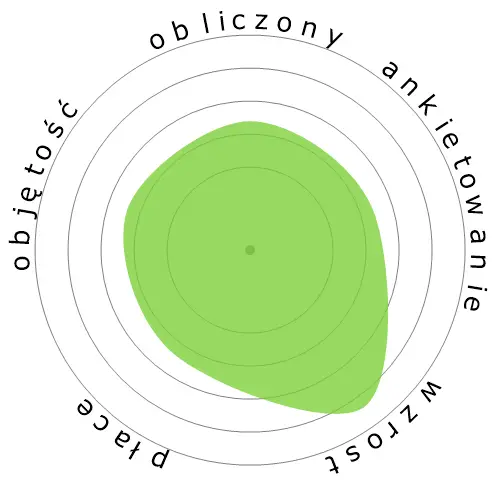Stewardesy/Stewardzi




Ludzie również oglądali
Obliczone ryzyko automatyzacji
Niskie ryzyko (21-40%): Zawody na tym poziomie mają ograniczone ryzyko automatyzacji, ponieważ wymagają połączenia umiejętności technicznych i skoncentrowanych na człowieku.
Więcej informacji na temat tego, czym jest ten wynik i jak jest obliczany, jest dostępne tutaj.
Ankieta użytkownika
Nasi goście zagłosowali, że jest małe prawdopodobieństwo, iż ten zawód zostanie zautomatyzowany. To ocena jest dodatkowo wspierana przez obliczony poziom ryzyka automatyzacji, który szacuje 38% szansę na automatyzację.
Jakie są Twoje zdanie na temat ryzyka automatyzacji?
Jakie jest prawdopodobieństwo, że Stewardesy/Stewardzi zostanie zastąpione przez roboty lub sztuczną inteligencję w ciągu najbliższych 20 lat?
Nastroje
Poniższy wykres jest zamieszczany wszędzie tam, gdzie istnieje znaczna liczba głosów, aby przedstawić istotne dane. Te wizualne reprezentacje pokazują wyniki ankiet użytkowników w czasie, dostarczając istotnych wskazówek dotyczących trendów nastrojów.
Nastroje w czasie (rocznie)
Wzrost
Liczba ofert pracy na stanowisku 'Flight Attendants' ma wzrosnąć 9,9% do 2033
Całkowite zatrudnienie oraz szacowane oferty pracy
Zaktualizowane prognozy mają być dostępne 09-2025.
Płace
W 2023, mediana rocznej pensji dla 'Flight Attendants' wynosiła 68 370 $, czyli 32 $ za godzinę.
'Flight Attendants' otrzymali wynagrodzenie wyższe o 42,3% od średniej krajowej, która wynosiła 48 060 $
Płace z biegiem czasu
Objętość
Od 2023 roku zatrudnionych było 126 020 osób na stanowisku 'Flight Attendants' w Stanach Zjednoczonych.
To oznacza około 0,08% zatrudnionej siły roboczej w całym kraju.
Inaczej mówiąc, około 1 na 1 tysiąc osób jest zatrudnionych jako 'Flight Attendants'.
Opis stanowiska pracy
Monitoruj bezpieczeństwo w kabinie samolotu. Świadcz usługi dla pasażerów linii lotniczych, wyjaśniaj informacje dotyczące bezpieczeństwa, podawaj jedzenie i napoje oraz reaguj na incydenty awaryjne.
SOC Code: 53-2031.00


Komentarze
Leave a comment
Plus, robots can't do such things as CPR or use a first aid kit, for example. So, it's pretty risky.
And by the way flight attendants are there to save u not to make u happy.
First priority is safety the If it’s possible the service time will come.
Given the recent horrific experiences passengers had to endure from these "flight attendants", I see machines replacing these incompetent humans in the future. It'll save the airlines plenty of revenue and avoid lawsuits and having to pay these poorly trained service attendants for mediocre to dismal services provided.
The only ones to blame would be the flight attendants themselves, because a machine did a better job than they ever would.
For example,
Today : 10 human flight attendants
Future: 1-3 human flight attendants, 7+ robot flight attendants.
Capish? :P
I have witnessed a decline in the manners and decorum of the passengers traveling. Possibly, the added stress to passengers of airport safety procedures has taken a toll on their nerves. I remember when friends and family could accompany passengers to the gate. Now, the seats are packed in like sardines in a can.
Airline competition made the way for no-frills service and more passengers in smaller seats on airplanes. This has taken a toll on everyone's stress levels. Still, I see friendly FAs who are doing their best to accommodate everyone onboard and assuage those who are already frazzled by the time they take their seats.
A robot may make the dispersion of in-flight commodities easier but it can never take care of all of the emergencies that FAs are trained to handle, the medical emergencies, the duplicate and other seating problems, the myriad of human interactions that FA's handle, unaccompanied children, wheelchair passengers, interaction with cockpit and ground staff, etc., etc. the list goes on, not even considering a major emergency like a hijack incident.
You have vastly underestimated the uber-selective hiring, initial and ongoing training that FAs have. Did you know that they have to take FAA-mandated emergency testing yearly on every airplane which they are qualified to work and pass the test with a 90-100% grade. This includes physical testing in airplane simulators., first aide, resuscitation and cardio procedures etc.
If you see an FA behaving in the unprofessional manner you have described, you should write a letter to the airline about that employee.
Zostaw odpowiedź na temat tego zawodu